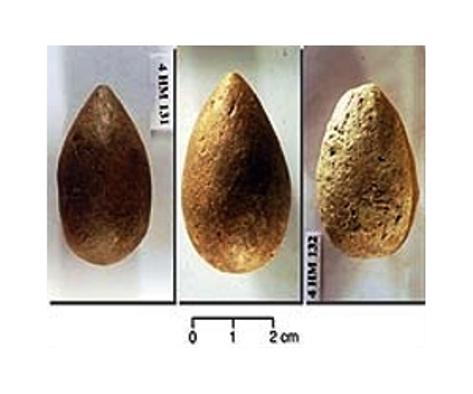Ancient slingers added insult to injury, researcher says
Source -http://www.spacewar.com/reports/Ancient_slingers_added_insult_to_injury_researcher_says_999.html
Centuries before Allied bomber crews would send gleefully personalised ordnance to Adolf Hitler, ancient skirmishers mastered the art of enemy taunts by slingshot, according to a researcher.
Sling bullets recovered from the battlefields of Egypt, Greece and Rome often carry inscriptions designed to add insult to injury, archaeologist Amanda Kelly told an Irish Institute of Hellenic Studies lecture.

Slingers, also known as sphendonetai, have been used in warfare through antiquity, from the Persian Wars and the endless fighting between Greek city states to Alexander the Great's campaigns and the Roman conquest of Britain.
Julius Caesar noted in a treatise that they were particularly useful against war elephants despite being a low-class division of light infantry, said Kelly, a classics professor at the National University of Ireland, Galway.
"There is very little you can use against an elephant," she said.
Some bullets were marked with personalised images any soldier could recognise such as bovine heads. Others were more elaborate, bearing the names of army generals, cities or the blacksmiths who cast them in lead.
And quite often, the missiles packed a verbal as well as a physical punch.
"Perhaps the most unexpected element is the humour involved," Kelly said.
She cited examples of Athenian sling bullets that read "Take that" or Cypriot versions saying "This is yours." More advanced taunts speak of male genitalia, impregnation and other sexual references.
Shot from the island of Corfu bore an inscription asking that they "be lodged well" in their intended targets while Thracian bullets promised "pain".
"The taunt is a weapon as damaging as the blow...and these bullets could penetrate armour," Kelly said.
Some researchers have reasoned that an ancient bullet weighing 40 grammes could fly at 100 kilometres (62 miles) an hour to a distance of 400 metres, she said.
Aside from boosting morale and dampening enemy spirits, inscribed bullets indicated the literacy of an army and that of its opponents as there was little point in employing the weapon unless both sides understood its meaning.
It was a device so popular that it is still in use centuries later, from World War II to the Korean War and US operations in Afghanistan, Kelly noted, pointing to an image from USS aircraft carrier Enterprise taken a decade ago.
"High Jack (sic) this fags", reads a message to insurgents chalked onto a bomb loaded onto an American fighter jet.